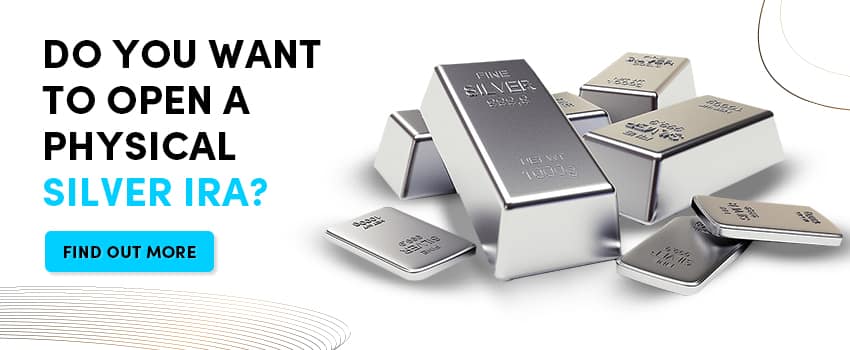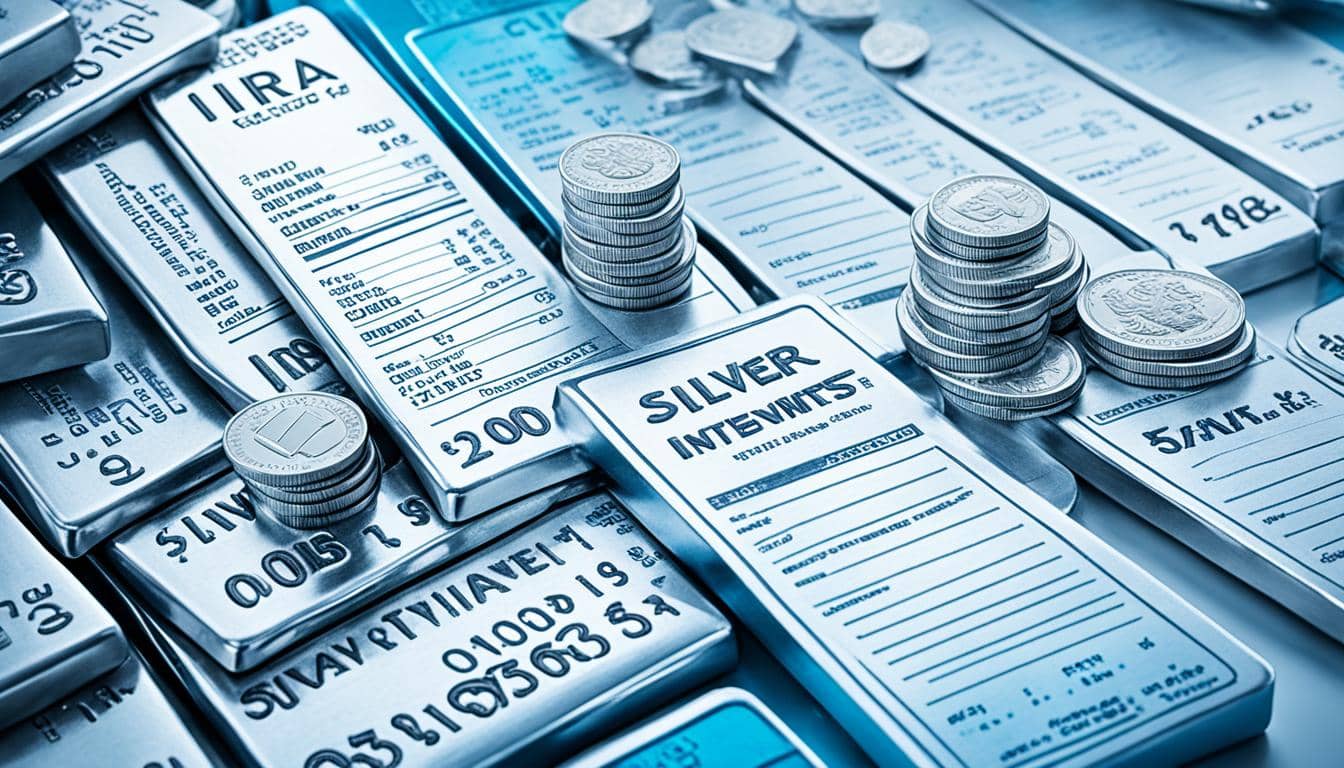Silver Investment IRA: Secure Your Retirement

Imagine living comfortably in retirement, without financial stress. Picture having the freedom to chase your dreams, travel, or spend time with family. Achieving this dream is something many of us want.
The economic world today is full of ups and downs. Traditional investments might not be enough to keep your retirement safe. A silver investment IRA could be the answer. It mixes your savings with the steady and growing value of silver. This mix can keep your future secure and fight off market changes.
Key Takeaways:
- Investing in silver for retirement can provide diversification and act as a hedge against inflation.
- A silver IRA account offers benefits such as tax advantages and protection during market downturns.
- Starting a silver IRA involves choosing a reputable custodian and funding your account through rollovers or transfers.
- Top silver IRA companies include Augusta Precious Metals, Birch Gold Group, and Noble Gold Investments.
- Silver bullion and silver coins are popular options for silver IRA investments, offering both the value of the metal and potential appreciation.

Why Invest in Silver for Retirement?
Investing in silver for retirement has many benefits. It is a real asset that keeps its worth over time. Silver helps protect against inflation and adds variety to your savings. It is used in many industries, which may increase its demand. Adding silver to your retirement plans through a silver IRA could improve your financial future.
The Tangible Asset that Preserves Value
Silver is valuable and has always been. It’s not like paper money that can lose value due to inflation. Having silver means you have something real that can save your money’s worth from inflation.
Diversification and Contingency Planning
Adding silver to your savings can lower risks and protect you from market swings. Unlike stocks and bonds, silver can perform differently. By investing in silver, you may reduce the bad effects of economic ups and downs.
Industrial Demand and Potential Growth
Silver is not just for saving; it’s used in tech, healthcare, and green energy. As these areas grow, they will need more silver. This can raise its value. Investing in silver means you could gain from these trends.
A Silver Investment IRA for Long-Term Financial Security
A silver IRA can strengthen your retirement plans. This account lets you keep real silver in a tax-friendly way. It combines diversification, safety, and chance for value increase. A trusted custodian can help you set up your silver IRA and keep your silver safe.
Types of Silver IRA Investment Options
Investing in silver in an individual retirement account (IRA) offers different choices. You can pick based on your investment preferences. Two common options are silver bullion IRA investing and silver coins for IRA investment.
Silver Bullion IRA Investing
Investing in silver bullion IRA means buying silver bars or coins. They are kept in a self-directed IRA. Owning silver directly lets you benefit if silver’s demand and price go up. Its value matches the current market price of silver.
Silver Coins for IRA Investment
Investing in silver coins is another way. Certain coins, like American Silver Eagles or Canadian Silver Maple Leafs, are allowed in an IRA. These coins have the silver’s value and might increase in value as collectibles. Collectible value depends on rarity, history, condition, and demand.
Both silver bullion and coins are good for your IRA. They offer a chance to grow your investment with silver’s value. Think about your investment goals and what you prefer. This could be owning physical silver or having collectibles.
“Investing in silver in an IRA helps diversify and grow your investment over time. Whether bullion or coins, make sure they fit IRA rules. Always think about your long-term investment goals.” – Financial Advisor
Benefits of a Silver IRA Account
A silver IRA account helps you diversify your retirement savings. Unlike just stocks and bonds, it can reduce risk in your portfolio. Silver’s unique qualities make it a strong guard against market swings. A silver IRA might also offer tax breaks, like growing tax-free in a Roth IRA. Choosing a solid silver IRA custodian is key for safety and managing your silver.
The Importance of Diversification
Diversifying your retirement savings is critical. Including silver can balance your portfolio’s performance. Silver’s value can rise when the economy is unsure, unlike stocks and bonds. This makes it a smart choice for those planning for the future.
Hedging Against Market Volatility
Silver often moves differently from stocks and bonds. It can be a safe choice when other investments drop. Adding silver to your IRA can keep your savings more secure in uncertain times.
“Silver has a long history of preserving wealth and acting as a hedge against inflation.” – Financial Advisor
Tax Benefits of a Silver IRA
A silver IRA comes with tax perks. You can grow your investment without taxes in a Traditional IRA. Or, withdraw money tax-free with a Roth IRA. This can save you money when you’re retired and ready to use your savings.
Choosing the Best Silver IRA Custodian
Finding the right custodian for your silver IRA is very important. They handle your investment’s care and security. Look for someone reputable, with fair fees and good customer service. This ensures your investment is safe and well-managed.
| Custodian | Features | Rating |
|---|---|---|
| Augusta Precious Metals | White Glove Customer Care and free educational webinar. | 5/5 |
| Birch Gold Group | Competitive fees and exceptional customer service | 4.9/5 |
| Noble Gold Investments | Flexible investment options and Exclusive Texas Storage Option. | 4.7/5 |
Look at the custodian’s reputation, experience, and fees when choosing. Also, consider how they store silver and read customer reviews. Do your homework and maybe talk to a financial advisor to make a good choice.
How to Start a Silver IRA
Starting a silver IRA takes a few key steps. These are important for your success. They help make sure your retirement savings include the perks of investing in silver. Let’s get into the details.
Choose a Reputable Silver IRA Custodian
The first step is finding a good silver IRA custodian. You want someone reliable and with a history of secure storage. Take your time to look at different custodians. Find one that matches your investment aims and gives you trustful services.

Fund Your Silver IRA Account
After choosing a custodian, it’s time to put money into your silver IRA. You can use funds from an old retirement account, like a 401(k) or a regular IRA. You have two main ways to do this: direct transfer and 60-day rollover.
A direct transfer moves money straight from one custodian to another. This is easy and smooth. The 60-day rollover means you get the funds yourself. Then, you have 60 days to put them into your silver IRA. If not, you might face tax issues.
Select Suitable Silver Investments
With your silver IRA funded, it’s time to pick your silver investments. You might choose silver bullions or coins. Just be sure whatever you pick is allowed by the IRS to be in an IRA.
Image:
The Advantages of Starting a Silver IRA
“Investing in silver through a silver IRA provides diversification and can act as a hedge against inflation, offering long-term financial security for retirement.”
There are many good things about having a silver IRA. It lets you stretch your investments beyond just stocks and bonds. Silver doesn’t move with the market much, so it protects you against its ups and downs. Also, silver keeps its value well over time, helping you fight inflation.
Having actual silver gives you the comfort of real, tangible ownership. Plus, silver is used in a lot of industries. This could mean its demand and value might go up, possibly boosting your nest egg in the long run.
The Silver IRA Rollover Process
Moving funds from an existing retirement account into a silver IRA is important for investors wanting diverse portfolios. It’s vital to know the silver IRA rollover steps. This helps ensure a smooth change while following IRS rules.
Direct Rollover:
To do a direct rollover, transfer funds right from one retirement account custodian to another. First, you must tell your current custodian the transfer details. Then, funds move straight from your old account to the new silver IRA custodian. This way avoids any taxes or penalties.
Indirect Rollover:
With an indirect rollover, you first get the funds from your current retirement account. Then, you have 60 days to put them into a silver IRA. This avoids tax troubles. It’s key to finish this in time and follow IRS rules to keep your savings’ tax benefits.
During this switch, working with a trusted silver IRA custodian is smart. They help with forms and make sure the transfer goes well. Always talk to a tax expert or financial advisor. They can explain tax impacts and any limits linked to the rollover.
Get a free Silver and Gold Guide from Noble Gold Investments!

Benefits of a Silver IRA Rollover
A silver IRA rollover can bring many perks:
- Diversification: A rollover adds silver to your retirement mix. This diversifies beyond usual assets like stocks and bonds, lowers risk, and might boost returns.
- Protection Against Inflation: Silver can guard against inflation. Its value often goes up when inflation lowers the worth of money.
- Preservation of Wealth: Silver’s real nature and scarcity make it good for keeping wealth safe over time.
- Portfolio Stability: Since silver moves differently from other assets, it can steady your mix during rough market times. It offers stability and growth chances.
Knowing the silver IRA rollover steps and its benefits lets investors protect and possibly grow their retirement savings.
Note: The image above visually summarizes the silver IRA rollover process, showcasing the steps involved in moving funds from an existing retirement account into a silver IRA.
Top Silver IRA Companies
Choosing a silver IRA company for retirement is big. You must look at their reputation, how much they charge, their customer service, and where your silver will be kept. Here are some top choices:
- Augusta Precious Metals: Augusta is all about IRA know-how, especially with silver. They have learning materials and various silver investment paths for retirement plans.
- Birch Gold Group: Known for trustworthiness, Birch Gold Group impresses with its tailored services, fair prices, and safe silver IRA storage.
- Noble Gold Investments: Noble Gold Investment has a big selection of metals for IRAs, valuing customer happiness, fair pricing, and secure storage including an option for exclusive storage in the State of Texas!
Before picking a silver IRA firm, do your homework. Compare services, charges, and reputations. See if what they offer fits your investment goals. Choosing a top-notch silver IRA company means securing and growing your retirement savings.

Comparing Top Precious Metals IRA Companies
| Company Name | Reviews | Investment Options | Fees/Minimum |
|---|---|---|---|
| Augusta Precious metals | ⭐⭐⭐⭐⭐ | Gold, silver, platinum | No fees for up to 10 years with qualifying purchase. High 50K IRA minimum. |
| Birch Gold Group | ⭐⭐⭐⭐⭐ | Gold, silver | Competitive Fees, low 10K IRA Minimum. |
| Noble Gold Investments | ⭐⭐⭐⭐⭐ | Gold, silver, platinum, palladium | Competitive Fees, 20k IRA Minimum. |
Investing in Silver Bullion
Investing in silver bullion can be a good choice for your silver investment IRA. Silver bullion means physical silver in bars or coins. It must meet specific standards for weight and purity. Owning it lets you directly own precious metal. This can lead to profit as demand for silver goes up.
It’s key to buy silver bullion from trusted dealers for your IRA. This makes sure your bullion is real and good quality. It also meets IRA rules. Choosing a reliable dealer means you can trust the value and realness of your silver.
The silver bullion’s value changes with the market price of silver. As silver prices go up or down, so does your bullion’s value. Keep an eye on silver prices. This helps you make smart choices and possibly increase your IRA’s value.
Silver bullion ownership has its perks, like actually having the metal and chances for growth. It’s a solid asset in unsure economic times. Silver’s limited amount and many industrial uses also boost its growth potential. This makes it a great choice for your retirement savings.
“Investing in silver bullion provides tangible and secure ownership of a valuable asset with long-term growth potential.”
Considering silver bullion for your IRA needs careful thought. Think about your risk comfort and investment goals. Talking to a financial advisor can help. They can guide you on how much silver bullion to have in your investment mix.
| Silver Bullion Advantages | Silver Bullion Considerations |
|---|---|
|
|
Think well about the pros and cons of silver bullion investing. Making well-informed choices helps you meet your retirement and risk goals. Silver bullion can diversify your IRA. It offers possible growth and a physical asset for your financial future.

Silver Coins for IRA Investment
Silver coins are a great choice for IRA investments. Certain silver coins like the American Silver Eagles, Canadian Silver Maple Leafs, and Australian Silver Kangaroos fit IRA requirements. These coins are valuable not just for the silver, but for their potential numismatic value too.
Numismatic value is the coin’s collector value. It depends on its rarity, history, condition, and how much people want it.
Adding silver coins to your IRA brings benefits of owning precious metals. Plus, they could grow in value because of their rarity and demand.

Conclusion
Putting money into a silver IRA can be a wise choice for securing your retirement. It lets you spread out your investments, lowering the risk of losing money due to inflation. To really benefit, you need to pick a trusted silver IRA custodian and follow the rollover steps closely.
Both silver bullion and coins are good for your IRA. Silver bullion lets you own physical silver. On the other hand, silver coins might also grow in value because of their rarity and design.
Before diving into silver IRA investment, check out the leading silver IRA firms. Also, talking to a financial advisor can help tailor your investment plan. With a solid strategy, silver can help you look forward to retirement with less worry.
FAQ
Why should I consider investing in silver for retirement?
Investing in silver for retirement has many benefits. It can help diversify your portfolio. It also protects against inflation and may grow over time.
What are the different options for investing in silver within an IRA?
There are two main options for silver IRA investing. You can choose physical silver bullion bars or coins. Or you can invest in certain silver coins for your IRA.
What are the benefits of having a silver IRA account?
A silver IRA helps you diversify your investment mix. It also offers protection against market swings. Plus, you might get some tax benefits.
How do I start a silver IRA?
To start a silver IRA, first find a trusted silver IRA custodian. Then, fund your account by moving over existing funds. Finally, pick the right silver investments for you.
What is the process for a silver IRA rollover?
A silver IRA rollover lets you move funds from another retirement account. You can do a direct or indirect transfer into a silver IRA.
Which are the top silver IRA companies to consider?
Top silver IRA companies include Regal Assets and Goldco. Birch Gold Group, Augusta Precious Metals, and Merit Gold & Silver are also good choices.
Why should I consider investing in silver bullion?
Investing in silver bullion lets you own physical silver. Its price might go up as demand increases, giving you potential profit.
Can I invest in silver coins for my IRA?
Yes, you can include certain silver coins in an IRA. American Silver Eagles and Canadian Silver Maple Leafs are popular choices.
Should I consider investing in silver coins or silver bullion for my silver IRA?
Your choice between silver coins and bullion depends on what you prefer and your investment goals. Both offer unique benefits for investors.
Source Links
- https://www.fool.com/investing/how-to-invest/stocks/how-to-invest-in-perplexity-stock/
- https://www.usgoldbureau.com/news/the-wilma-mankiller-quarter
- https://www.gobankingrates.com/investing/stocks/how-much-youd-have-now-if-you-invested-your-tax-refund-in-microsoft-in-2023/











































